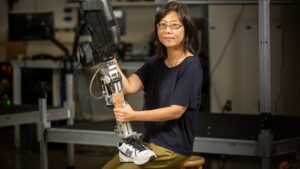
Researchers from McMaster University and the University of Pittsburgh have successfully created the first functionally complete logic gate, a NAND gate, using only visible light and a soft material. This groundbreaking discovery, published in *Nature Communications* on November 20, 2025, represents a significant advancement in the field of materials that compute, where materials themselves process information without relying on traditional electronic circuitry.
Fariha Mahmood, the first author and a postdoctoral researcher at the University of Cambridge, expressed her excitement about the achievement, stating, “To see these materials not only respond to light but also perform a logic operation feels like watching the material ‘think.’ It opens the door to soft systems making decisions on their own.” Mahmood worked on this project for over a decade, beginning her research on gels as an undergraduate at McMaster.
Joining her in the study are Anna C. Balazs, a distinguished professor of chemical and petroleum engineering, Victor V. Yashin, a research assistant professor at Pitt’s Swanson School of Engineering, and Kalaichelvi Saravanamuttu, a professor of chemistry and chemical biology at McMaster. The team demonstrated that shining three self-trapped light beams into a specially engineered hydrogel can execute a NAND logic operation, a fundamental building block of computing. This achievement establishes soft, photoresponsive materials as a viable platform for autonomous systems capable of computation.
Material Innovation and Theoretical Foundations
The research builds on earlier theoretical work by Balazs and the late Steven P. Levitan, a former professor of electrical and computer engineering at the University of Pittsburgh. Their studies, including a 2016 publication in *Science Advances*, introduced the concept of oscillating chemical gels as networks for sensing, communicating, and computing. These foundational ideas have paved the way for “materials that compute,” which can perform tasks such as pattern recognition and decision-making without conventional circuitry.
Balazs remarked on the significance of the study, stating, “This is what we’ve always imagined—materials that don’t just respond to a stimulus, but process it.” The breakthrough material at the heart of this research is a merocyanine-functionalized hydrogel that contracts when illuminated. When a laser beam enters the gel, the local contraction increases the refractive index, allowing the beam to “self-trap.” This phenomenon results in the beam becoming narrower and brighter as it travels through the material.
In previous work, Saravanamuttu and colleagues found that two competing beams of light within the same gel inhibit each other’s ability to self-trap. Adding a third beam revealed new interaction patterns, enabling the team to map a logic operation onto the soft material.
Future Implications and Applications
While this system does not compete with semiconductor processors in terms of speed or data density, its implications are profound for various fields where materials must make independent decisions. Potential applications include soft robotics, self-regulating medical devices, and sensors designed to operate in inaccessible environments.
Balazs noted, “These systems don’t aim to replace silicon—they aim to mimic the remarkable autonomy of biological materials.” The team’s work introduces a new way of thinking about material functionality, demonstrating that computer logic can be enacted through a material’s own chemistry and physics.
Importantly, the study establishes a framework for conducting multiple logic operations simultaneously within the same gel sample. Since the input and output signals are all based on light beams, they can be routed and combined without the need for wiring, opening new avenues for material design.
Reflecting on the project’s significance, Balazs shared a personal milestone: “To see that vision realized experimentally is incredibly meaningful.” The study not only advances scientific understanding but also fulfills the aspirations established over a decade ago.
For more detailed insights into this groundbreaking research, refer to the article: Fariha Mahmood et al, “A functionally complete logic gate in a soft photoresponsive hydrogel,” *Nature Communications* (2025). DOI: 10.1038/s41467-025-64960-4.







